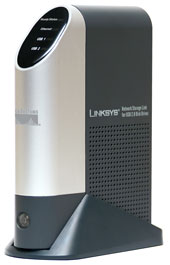uNSLUng is the way to go
 The SLUG’s alive! Friday I bought another Linksys NSLU2 and spent most of the weekend hacking it. I re-flashed it with the uNSLUng v5.5 beta firmware, configured a thttpd web server, a CUPS print server and a set up an automated torrent downloader.
The SLUG’s alive! Friday I bought another Linksys NSLU2 and spent most of the weekend hacking it. I re-flashed it with the uNSLUng v5.5 beta firmware, configured a thttpd web server, a CUPS print server and a set up an automated torrent downloader.
The little Linksys box is sold as a home-network NAS device for external USB drives. It does that quite well: the first one I bought runs on the OEM firmware and reliably makes my 300GB main storage drive available on our little home network. When I read more about this clever $90-device, it became clear that I could replace two of the full-size PCs that normally run 24/7 in our basement to make printers available and run other processes.
 So, I hooked up an old backup harddrive, and dug into the Linux system of my SLUG. The nslu2-linux.org site is extremely helpful and provides how-tos and documentation. I am not much of a Linux hacker, but this is a great opportunity to figure out some of this stuff. After some RTFM moments I got the web server and print server going. The only thing that bothers me about this setup is the noisy damn harddrive. I’ll see if I’ll get a new, quieter drive, or maybe run this setup off of a flash drive. In any case, I’ll have to redo the whole thing, since the uNSLUng process does move parts of the OS to the USB device and the additional packages are also installed on the USB device.
So, I hooked up an old backup harddrive, and dug into the Linux system of my SLUG. The nslu2-linux.org site is extremely helpful and provides how-tos and documentation. I am not much of a Linux hacker, but this is a great opportunity to figure out some of this stuff. After some RTFM moments I got the web server and print server going. The only thing that bothers me about this setup is the noisy damn harddrive. I’ll see if I’ll get a new, quieter drive, or maybe run this setup off of a flash drive. In any case, I’ll have to redo the whole thing, since the uNSLUng process does move parts of the OS to the USB device and the additional packages are also installed on the USB device.
The reason is that the “quiet computer” aspect of this project is half the fascination. With a flash drive, or two, plugged into the SLUG, this is a quiet, low-power computer, smaller than a CD box-set and more powerful than my old Pentium I laptop. The processor is a 130 MHz ARM on an Intel board, which is apparently what Linksys usually does. The small built-in RAM disk can be supplemented with external storage, and when you add a paging file, this little box can be thoroughly souped up.
Finally, if you really want a “high-performance SLUG” you can overclock the CPU, or rather de-underclock it. The little box comes throttled down, and following the instructions, you can pop off a transistor and restore it to its full 266 MHz glory. That’ll be a project for another three-day weekend …
January 29th, 2006 at 1:58 pm
[…] ST uNSLUng v.2.0 Last night I stayed up until 2:00 AM tinkering with my SLUG server – a modified Linksys NSLU2 device. V1 ran off of an old, noisy hard dr […]
May 9th, 2010 at 5:45 am
The first time that i tried overcloking over a year ago, my CPU got overheated and got fried.::”